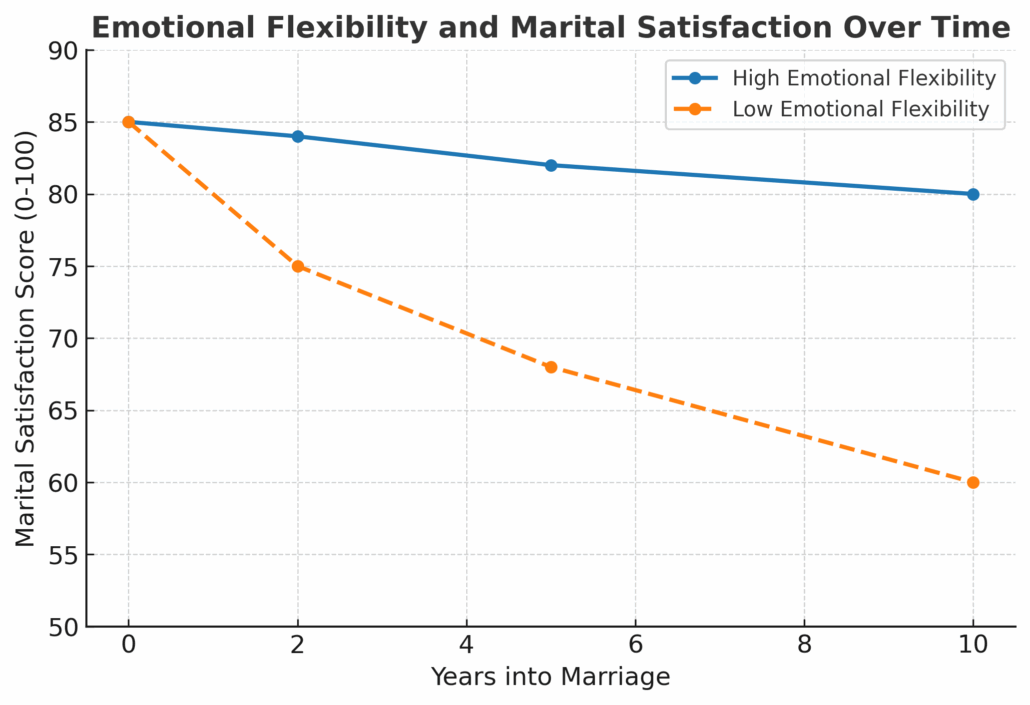Do you ever feel like your marriage is stuck in the same arguments, the same patterns, or the same disconnect?
When couples hit a crossroads—wondering whether to keep fighting for their marriage or let go—it’s tempting to focus on the big questions: Do we still love each other? Can we trust again? Is this fixable?
But research shows that one skill quietly predicts the answer: emotional flexibility—the ability to adapt, respond thoughtfully, and stay connected under stress.
Couples who practice it bend instead of breaking. Those who don’t often find themselves locked in rigid cycles of disconnection.
If you’re weighing the future of your relationship, emotional flexibility is a powerful signal of whether your marriage can grow stronger or drift apart. Let’s explore why it matters, how it impacts couples, and how you can build it together.

Figure: Couples with high emotional flexibility maintain greater marital satisfaction over time compared to those with low flexibility. While both start at similar levels, the ability to adapt and repair under stress helps prevent the steep declines in satisfaction seen in less flexible relationships.
Why Emotional Flexibility Matters in Marriage
1. It Strengthens Resilience
A meta-analysis of 174 studies found that higher psychological (emotional) flexibility among couples strongly correlates with better relationship health—greater satisfaction, reduced conflict, and more emotional support and intimacy. Inflexibility, conversely, is linked to negative outcomes like attachment anxiety or aggression1.
2. It Builds Long-Term Stability
Emotion regulation—specifically, the ability to downregulate negative emotions during conflict—is tied to higher marital satisfaction, both in the moment and over time. This was especially true for wives’ ability to manage intense emotions effectively2.
3. It Creates Healthier Relationship Patterns
Emotionally flexible individuals can perceive cues, apply the right coping strategy, and adjust as needed—all of which fuel healthier interaction patterns under stress3.
Couples high in emotional flexibility maintain more stable levels of satisfaction over time, while inflexible couples often decline steeply.
How to Cultivate Emotional Flexibility in Your Marriage
Through intentional practice, couples can build flexibility and resilience together:
- Stay open and present. Be willing to engage with challenging emotions rather than avoiding them4. Mindfulness and shared emotional awareness matter.
- Embrace shared values. Let your decisions reflect what both of you truly care about, especially when you’re stressed or pulled in different directions5.
- Repair actively after conflict. Use loving gestures—it might be as small as a pause, an “I’m sorry,” or a tender touch—to reset connection6.
- Build awareness together. Notice when flexibility wanes—when you’re shut down, stuck in patterns, or emotionally distant—then gently practice shifting back toward connection7.
Key Takeaways for Couples at a Crossroads
- Emotional flexibility is not a nice-to-have—it’s essential for making marriage resilient and sustainable when facing stress.
- Regular flexibility vs. rigidity is a clearer signal than grand events—this trait differentiates marriages that endure from those that unravel.
- Developing emotional flexibility together is an actionable path forward, not just a lofty ideal.
- If emotional flexibility is low, it may signal the need for focused work—whether through retreats, therapy, or guided reconnection.
Emotional flexibility won’t eliminate conflict—but it will determine how you move through it. Couples who adapt together not only survive challenges but often come out stronger, more connected, and more resilient than before.
FAQ: Emotional Flexibility in Marriage
1) What exactly is “emotional flexibility”?
It’s your ability to notice what you’re feeling, stay present, choose a response that matches the moment, and pivot when needed—rather than reacting on autopilot. Higher flexibility strongly correlates with better relationship health.¹ ³ ⁴
2) How is emotional flexibility different from “never arguing”?
It’s not about avoiding conflict; it’s about how you move through it—down-regulating reactivity, staying connected, and repairing faster.² ⁶
3) Can emotional flexibility really predict marital satisfaction long-term?
Yes. Studies show couples who regulate emotions effectively during conflict report higher satisfaction both immediately and years later.² ⁷
4) What makes couples get “rigid”?
Common triggers: threat/criticism, exhaustion, unspoken expectations, and old patterns from earlier relationships or family systems. When stress rises, we default to rigid scripts unless we practice new ones.³ ⁴
5) How do we build emotional flexibility together (quick start)?
- Pause → Name → Choose: “I’m flooded; I need 10 minutes, then let’s try again.”² ⁶
- Repair rituals: short apologies, appreciation, gentle touch, or a shared breath.⁶
- Value-based choices: ask, “What action serves us right now?”⁵
- Micro-practice daily: 5 minutes of mindful check-ins; one small pivot each day.⁴
6) What if only one of us is willing to work on this?
One flexible partner can lower overall volatility and model a different pattern, which often invites the other to engage—especially when repairs are consistent and blame is downshifted.¹ ³ ⁶
7) Is mindfulness required? I’m not a “meditation person.”
Mindfulness is a tool, not a mandate. Any practice that helps you notice, name, and choose (journaling, breathwork, prayer, brief time-outs) builds the same muscle.⁴
8) How do we measure progress?
Look for leading indicators: shorter conflicts, quicker repair, fewer “never/always” statements, and better recovery after tough talks. Long-term, track satisfaction and perceived support.² ⁷
9) When should we consider extra help (course, retreat, or therapy)?
If you’re stuck in looping arguments, avoidant shutdowns, or constant criticism/defensiveness—and your DIY fixes don’t stick—structured guidance can accelerate change.¹ ² ⁷
10) Will emotional flexibility “save” a marriage on its own?
It won’t replace trust-repair, boundaries, or shared values, but it’s a critical ingredient that makes all of those changes possible and sustainable.¹ ² ⁵ ⁶
11) What are a few evidence-based exercises we can try this week?
- Stress-reducing conversation (15 min): one talks, one listens/validates; swap.⁶
- Physiological self-soothing: agree on time-outs at ~90–120 seconds of flooding.² ⁶
- Values alignment check: pick a current decision; each names the top value it serves; choose a next step that honors both.⁵
12) Does flexibility mean I should tolerate hurtful behavior?
No. Flexibility serves connection and self-protection. It helps you set and hold boundaries without escalation. If safety is at risk, seek professional support immediately.² ⁷
Sources
- University of Rochester. (2022). Psychological Flexibility in Romantic and Familial Relationships.
- Bloch, L., Haase, C. M., & Levenson, R. W. (2014). Emotion regulation predicts marital satisfaction: More than a decade later. Emotion, 14(4), 745–753.
- Bonanno, G. A., & Burton, C. L. (2013). Regulatory flexibility: An individual differences perspective on coping and emotion regulation. Perspectives on Psychological Science, 8(6), 591–612.
- Kashdan, T. B., & Rottenberg, J. (2010). Psychological flexibility as a fundamental aspect of health. Clinical Psychology Review, 30(7), 865–878.
- Fowers, B. J., & Owenz, M. B. (2010). A eudaimonic theory of marital quality. Journal of Family Theory & Review, 2(4), 334–352.
- Gottman, J., & Silver, N. (2015). The Seven Principles for Making Marriage Work. Harmony Books.
- Karney, B. R., & Bradbury, T. N. (2020). Research on marital quality: Implications for policy. Policy Insights from the Behavioral and Brain Sciences, 7(2), 169–176.






